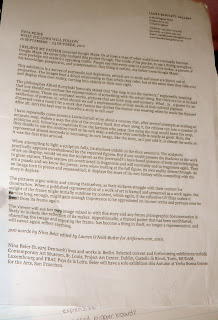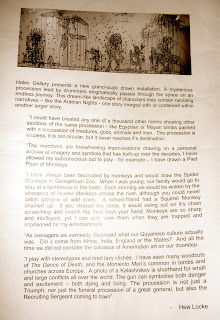video diary
These are a few examples of individual pieces or artists that I liked from the exhibition:
Swoon
Swoon's technical graffiti is amazing, with the sheer effort it must take. Each image is extremely detailed and worked into, with multiple subjects within the image. It is almost like the images are built up over time. Either way it is obvious that they aren't painted with spray paint. With further research I found out that Swoon uses painted paper cut outs that she then plasters to walls. It's a technique completely different to anything else I've come across before and I love the detailed effect it has. I'd like to research the techniques further that Swoon uses to see how simple it really is, and if it would be something I'd try myself.
Lucy McLaughlan
Lucy McLaughlan uses black and white palettes, similar to my own work, yet she also uses imagery that appears to be animal symbolism. All of the figures in her work are drawn in an exaggerated way so the faces are distorted. They are also all combined together to make a sort of pattern, added to by the wavy lines and small designs woven into the figures. I like how adventurous her designs her, how they manifest into different shapes that I wouldn't expect, yet I wouldn't pick this style to research into further.
Deadbeat Donny
I love Deadbeat Donny's punk, rough, edgy cartoon-like style; everything looks like it took little effort and as though the artist was scribbling over something important. The punk style appears to be aggressive and hasty, but its a style I like and appreciate. It seemed like the type of artwork that could be found on a schoolbook when a student is messing around, but I like that aspect of it; it doesn't look like "typical" graffiti in the contemporary sense but it's interesting and fun for that very reason.
Pure Evil
Pure Evil's work takes existing iconic images, and distorts or changes them for their own agenda. In "666" which I saw at the exhibition, the famous Beatle's album cover for "Sgt Peppers Lonely Hearts Club" has been transformed into a who's who of the most evil figures from history (or in Pure Evil's mind at least). What I liked most about this piece is the blatant cut and paste job used to make this seminal album cover an evil "parade". It looked like something I can do, and the simple way it was done made it look like a joke at your expense, but it still made you smile.


















